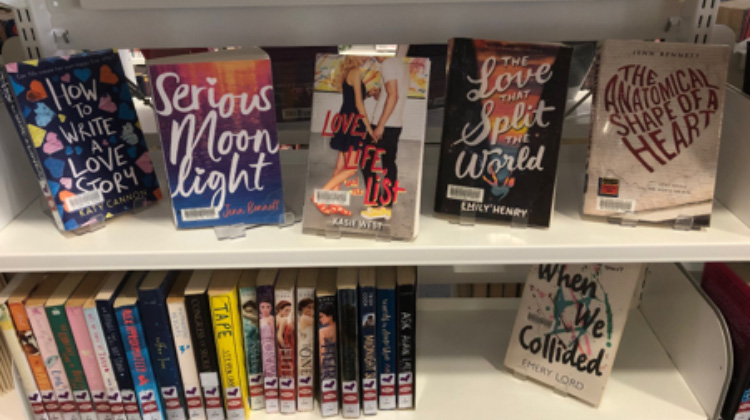Genrefication – Does it improve user engagement with Library collections?

We all know that reading is so important for students. Just take a look at some of the research by Josie Billington (2015), Mar, Oatley and Peterson (2009), and Anne Sullivan (2015). Benefits include, but are certainly not limited to, academic achievement, mental health wellness, increase in vocabulary, social and cultural awareness and relatedness, communication, emotional intelligence and knowledge of self. As a teacher librarian, I know and see the benefits of reading every day. It’s our number one priority (alongside digital and information literacy – we are pretty good at multitasking number one priorities) to get students reading. That’s why our school library’s collection is awesome — just ask our students. It’s been our goal to maintain a collection that is appealing, current, and reflective of our readers and yet also challenges them.
We are not afraid of change in our library. We regularly move furniture, signage, and collections. We rename, resticker and relabel. We trial, experiment and reflect. If it works, we keep it. If it doesn’t, we keep trying. Genrefication was something we wanted to try and we were excited about what it could bring to our library.
Genrefication has been a buzzword in school libraries in recent years, though the concept has been around much longer than that. My computer isn’t sure it is actually a word at all. It much prefers gentrification, which means, I have learnt, the process of renovating or improving a house or district so that it conforms to middle class tastes. Hmmm. In some ways that fits the overall theme of genrefication, our goal is certainly improvement, always. Are we conforming to ‘middle class tastes'? Or perhaps the tastes of our readers? That’s what we wanted to find out when we started the genrefication process. As school librarians, we are always on the lookout for something that can help increase student engagement with reading and literature. The evidence for genrefication was positive but limited in terms of evidence-based research. However, many espoused the benefits of moving to a more bookshop like arrangement.
Opinions about genrefication are divided on the benefit of such a move, and whether this step should apply to fiction or non-fiction collections (Pendergrass, 2013). Library consultants such as Kevin Hennah (Hennah, n.d) advocate for this bookshop model. Others cite the benefits, which include better loan statistics, a visual aid for collection development, and increased user engagement with the collection (Sweeney, 2013).
Once we had made the decision to genrefy our young adult fiction collection, we started the multi-stepped process of deciding which genres we would use, finding appropriate genre stickers for the books’ spines and deciding how we would group the collections. After moving the books and updating the catalogue and signage, all that was left was introducing the new arrangement to the students and discovering their reactions. Over the next year we monitored student use of the area, compared loan statistics to the previous few years and gathered some informal feedback. The results surprised us. And so, we started the next year with phase two of our genrefication process. Looking back, this second phase was just as, if not more, important than the initial decision and genrefication move. It’s where we learnt the most, and made the most improvements to the collection.
In our session at the 2020 Brisbane National Education Summit Capacity Building School Libraries Conference, From Genrefication to Readers’ Advisory and Beyond - What Really Works, Head of Library Services, Sue O’Brien, and I will outline our genrefication procedure and the results that surprised us. We will also explain our second phase of the genrefication process and what strategies we found the most effective in promoting reading and student engagement with our library collections. Because, at the end of the day, providing a love of reading that will equip students well into the future is the best gift we can give them. I look forward to seeing you at the Conference or bumping into you between the booths at the free expo. The National Education Summit is a fantastic opportunity for educators to come together to share ideas and experience for the benefit of our students. I hope to see you there.
References
Billington, J, (2015). Reading between the Lines: the Benefits of Reading for Pleasure, Quick Reads, University of Liverpool. manuscritdepot.com/documentspdf/Galaxy-Quick-Reads-Report
Hennah, K. (n.d.). Library Experience. www.kevinhennah.com.au/a-few-of-kevins-thoughts
Mar, R., Oatley, K. & Peterson, J. (2009). Exploring the link between reading fiction and empathy: Ruling out individual differences and examining outcomes. Communications. 34. 407-428. 10.1515/COMM.2009.025.
Pendergrass, D. J. (2013). Dewey or don’t we? Knowledge Quest, 42(2), 56-59. Retrieved from ezproxy.slq.qld.gov.au
Sweeney, S. (2013). Genrefy your library: Improve readers’ advisory and data-driven decision making. Young Adult Library Services, 11(4), 41-45. Retrieved from ezproxy.slq.qld.gov.au
Sullivan, A. (2015, Spring). The life-long benefits of reading for pleasure. School Librarian, 63(1), 5+. Retrieved from link.gale.com/apps/doc/A405924683
Billington, J, (2015). Reading between the Lines: the Benefits of Reading for Pleasure, Quick Reads, University of Liverpool. manuscritdepot.com/documentspdf/Galaxy-Quick-Reads-Report